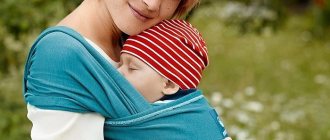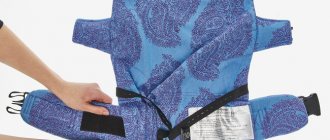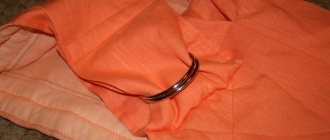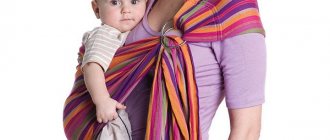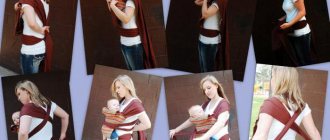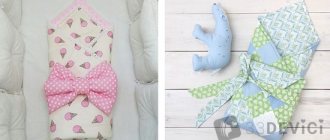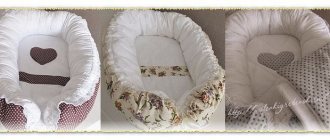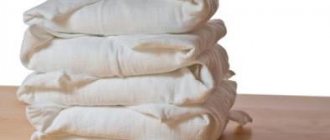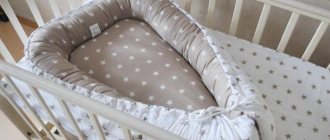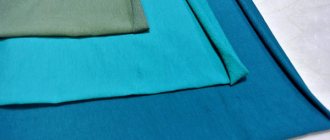Choosing fabric for a sling
What fabric is best to use to sew a sling with your own hands?
- Knitwear with interlock weave.
- Plain weave material.
- Twill.
- Jacquard.
As for colors, the choice is yours. The main thing is that the sling pleases you and your baby and is unique and original.
To make a sling with your own hands, choose a fabric that is dense, elastic and, of course, natural.
What else do you need to know before getting started? If you decide to make a sling with rings, purchase metal rings with a diameter of 7-8 cm in the accessories department of a fabric store.
If your goal is a sling, don’t forget to buy padding polyester for the straps. And choose threads in accordance with the thickness of the fabric from which you will sew your product.
Important point. Before you start cutting out the parts of the sling, the fabric from which you are going to sew it should be washed so that it shrinks.
It’s quite easy to sew a sling scarf, but you still need to learn how to wrap it correctly
Scarf
In order to sew a sling scarf, you will need a spool of thread and a piece of fabric 3-6 m long and 45-70 cm wide. Wider and longer is better. It will be more convenient for you to wrap a long sling, and as the baby grows, it takes up more and more space in it.
You can also focus on the position in which you will carry the child.
- “Cradle” (from birth) and “on the hip” (from 6 months) – 2.5-3 meters of fabric is enough.
- The same positions, but with the distribution of the fabric over 2 shoulders - 3.5-4 m.
- A universal sling scarf with the ability to carry a baby from birth to 3 years in any position - 4.5-6 m.
To determine which length is right for you, add a zero to the right of the clothing size you wear. And you will get the optimal sling length for you. You have size 46, you need to buy fabric for the sling 460 cm or 4.6 m. Owners of size 52 need to sew a sling 5 m 20 cm long.
Once you have decided on the size of the rectangle of fabric for the slig scarf, take the necessary measurements and cut it out. Then finish the edges (if it's not a hem) using a serger or a closed hem stitch. All. Your sling scarf is ready.
A ring sling is worn on one shoulder, unlike a scarf sling, which provides the opportunity to evenly distribute the load on both shoulders
With rings
A sling with rings can be made either using a stitch to secure the rings, or without sewing
You will need fabric 220x80 cm, a spool of thread matching the tone, and 2 metal rings with a diameter of 60 to 80 mm.
Sewing technology
- Measure the required length and width of the fabric and cut out a rectangle.
- Finish the edges with an overlocker or a closed hem stitch.
- Thread one end of the fabric through both rings and secure it with a few stitches.
- Throw the sling over your shoulder.
- Insert the other end of the fabric into the rings.
- Then thread it in the opposite direction into one ring.
- Adjust the position of the sling using the rings.
Making a sling with rings
This sling is also quite popular. It is convenient to put on and take off. You can adjust the length of the panel, change the position of the baby by laying it down or, conversely, giving it a sitting position. You can carry a baby in it from birth to one year. The inconvenience of this sling is that you have to wear it on one shoulder, often changing position.
Necessary materials
You will need fabric 220 - 240 cm long, 80 cm wide. The requirements for fabric are the same as for a sling - scarf. It is advisable to take double-sided fabric, it looks more beautiful. To make this carrier, in addition to the fabric, you need to buy rings with a diameter of 7 cm. With their help, you will attach the ends of the panel and adjust the position of the baby in the sling. Rings can be made of plastic or metal. Metal ones are preferable, they are much stronger. Pay attention to the threads you will use - they must be strong.
Sewing a sling with rings
- Sew the edges of the prepared fabric. Stitch them on a sewing machine or stitch them by hand.
- Take both rings, pass one end of the fabric through them, bend it 4 - 5 cm, and sew it to the fabric. For strength, make 3-4 stitches.
- Throw the fabric over your shoulder, insert the other end into the rings, and adjust the length of the fabric. Fix the other end well in the rings so that it does not jump out. To do this, pull it through two rings and in the opposite direction through one.
1. Take a fabric 2.20 m by 80 cm (preferably twill, jacquard weave - which stretches slightly diagonally) and 2 reliable rings (diameter at least 6 cm) 2. Process 3 edges of the flap so that the fabric does not fray 3. Thread the fabric into the rings 4. Sew the edge to the main fabric, secure the rings with several seams
Sling backpack and Fast sling
In addition to the slings themselves, there are other types of carriers for children: the so-called sling-backpack and fast-sling. As was written earlier, these devices are not inherently slings, because a sling is just a fabric sling, and both of these carriers have frame elements, fasteners, etc. However, modern mothers use the word “sling” in relation to any type of carrier.
Whether in a sling backpack or a fast sling, a child can only be in a sitting position with his legs apart. This is why both carriers are not recommended for babies under 4 months. The minimum requirement is that the child must confidently hold his head and be able to lift it while lying on his stomach, that is, the neck muscles must be developed (See the article about when a child begins to hold his head). It is better if the baby not only holds his head, but also sits independently (See the article about when a child begins to sit). The fact is that the back support in both carriers is regulated by the tension of the slings and it is rare that any mother can set the correct tension. You can tighten the lines too tightly or, conversely, too loosely. Incorrect tension of the slings loads the baby's spine inappropriately to his physical capabilities. All this dangerously affects the formation of vertebral curves and at an older age can manifest itself as curvature of the spine.
Ergo backpack, or sling backpack
sling backpack
Design:
Wide, dense straps that can be placed on the back either parallel to each other or crosswise. Back with headrest, darts, bolsters. Wide padded belt that fits mom's waist and hips. It is fastened with plastic fasteners, it is possible to adjust the tension of the back.
pros
- Divides the load between the back and hips, so that the mother does not have to bend under the weight of the baby.
- Allows you to carry your child face to face, behind your back and on your hip.
- It is easy to unfasten and fasten, so there will be no problems with getting your child in and out.
- Suitable even for children 2-3 years old.
Minuses
- Quite voluminous compared to carriers of other types and designs.
- Due to the frame and thick fabric, it can be hot in summer.
How to choose:
When choosing a sling backpack, you should mainly focus on the manufacturer’s recommendations and the child’s parameters. All manufacturers indicate the recommended height, weight, and age of the baby.
Where and when is convenient:
Thanks to its design, the ergo-backpack is comfortable for carrying a child for a long time, and it is perfect for older children.
Video instructions for using the ergo backpack:
Fast sling
Fast sling
Design:
It is very similar to the May Sling, but is fixed in a different way: the May Sling has long straps and a belt that are tied with a regular knot for fixation, while the Fast Sling has short straps and a belt that are fastened with fastex.
pros
- Very easy to use: it’s easy to get your baby in and out of the fast sling.
- Lightweight and takes up little space, it is better ventilated, so in hot weather it is more comfortable to carry a child in it.
Minuses
- The possibilities for carrying the child (only facing you) and adjusting the position of the straps (only crosswise) are limited.
- Due to the narrow belt, the entire load falls on the back, so carrying a child in a fast sling for a long time is not recommended.
How to choose:
When choosing a fast sling, it is important to pay attention to the strength of all fastenings. The straps and belt must be padded with padding polyester. By the way, a fast sling can be sewn to order, and skilled craftswomen can master the production themselves
By the way, a fast sling can be sewn to order, and skilled craftswomen can master the production themselves.
Where and when is convenient:
Best used for children who are not too heavy. Great for summer. It is also better to limit the time of continuous wearing so as not to provoke back problems.
Video instructions for using the Fast Sling:
We read further:
- There is another type of carrier - these are kangaroo carrier bags.
- How to choose a stroller for a newborn baby
You can check prices, read reviews, choose and buy slings in the Obstetrics online store -
You can also look into our online stores section and look for slings, carriers and backpacks in other online stores - https://razvitie-krohi.ru/veshhi-dlya-malyisha/luchshie-detskie-internet-magazinyi.
Mai-sling - a convenient Chinese guest
Many mothers do not dare to sew a May sling with their own hands: after all, the design is not the simplest, and the child should be completely safe. But mothers of slings, having figured out how to sew a mai sling, are reassuring. There won’t be any particular difficulties, although you definitely won’t be able to do it without an assistant typewriter. But the result in the form of an anatomically correct baby carrier that is easy to put on and take off is worth some effort, as is the amount saved.
A short master class on how to make a sling originally from China:
- When choosing a material, you need to choose linen, cotton or denim: they do not slip or stretch. Thick classic jeans are only suitable for a pocket; the straps should be made of other materials or also denim, but made of stretch fabric.
- By the way, about the pocket - this is the only part of the May-sling where you will need patterns for the pattern. The pattern will have a rectangle 44 cm long and 36 cm wide, you just need to take into account the seam allowances.
- By stitching and sewing the straps (175 cm long and 10 cm wide), mom will receive the simplest version of a May-sling that can already be used.
- Many needlewomen go further and attach a hood or headrest to the base.
There is also a May-sling version with a one-piece headrest, but it is more complicated in terms of sewing and leaves less room for creativity.
Types and models
Since ancient times, every mother, regardless of her location on the planet, has been trying to come up with a convenient way to transport her baby. And no one has yet come up with a more comfortable and cozy device than a fabric cradle. With its help, the child is close enough to his mother to feel safe. Mom’s heartbeat, the smell of her skin and a source of nutrition (breast) in the immediate vicinity allow the baby to be calm and the mother to go about her business without stopping to monitor her beloved child.
Now such devices are called differently: kangaroo backpack; ergo backpack; May-sling and others. But in terms of its versatility, the sling scarf comes first. It is used both as a “cradle” for newborns, and as a winding in more complex variations for growing toddlers.
What is it possible and what is dangerous to make a baby carrier from?
The main thing you need to pay attention to when making a sling is the material. It should be durable, not stretch too much and have a natural composition
You don’t have to buy a cut, but use available tools from the arsenal of any housewife.
- The use of a sheet is advisable only in the warm season and for home wear in those rare moments when there are no better options, because it is extremely difficult to ensure the anatomically correct position of the baby in it.
- The stole can be used both at home and outdoors, but mainly in the autumn-winter period. It is necessary to take into account that a sling is also clothing, therefore, in order to prevent overheating, you need to select a suit for the child accordingly.
- The sling can be made from a large cotton scarf measuring 150 by 100 cm (for use at home, sometimes a regular diaper is used). Such carriers are common among African women and are called kanga.
Kanga is a shawl carrier that is actively used in African countries.
Carrying from a scarf
A scarf can be used to carry a baby in a variety of ways.
- Cradle position. We fold the product lengthwise, throw it over one shoulder and tie it on the opposite thigh with strong knots. We form a cradle out of fabric and place the baby in it.
- Worn on the side. From the same starting position, fold the scarf over the shoulder and straighten it to the knot. As a result, an opening is formed where the baby can be seated.
- We move the knot to the chest, and the cloth of the scarf with the child back, thereby forming a position behind the back.
Do not forget that you cannot use such a carrier all the time. This method is only suitable for emergency situations when you need to free your hands for a while. For more frequent wear, you should get the right sling.
What should not be used to make a carrier?
A warm knitted scarf is unlikely to be suitable for proper carrying. As a rule, it is narrow and short for a sling scarf, and it is impractical to use it for a sling with rings due to the insufficient density of the fabric, because even with the required length, the product will not provide the necessary support for the baby’s back.
Using an ordinary square scarf, for example, the Pavloposad one, is an unsuitable option, because its standard dimensions of 80–90 cm will not allow you to securely secure the child. The material from which it is made also plays a role: wool will be prickly for the baby, and silk is too slippery and will not provide the necessary support.
What requirements must the sling material meet?
If you decide to take sewing a sling seriously and make it at home no worse than the representatives of leading brands, then carefully consider the choice of fabric. It is preferable to use cotton, linen and wool fabrics without synthetic fibers, so as not to cause allergies in the baby:
- for the warm season, chintz is well suited, but it is quite thin, so when sewing, the sling must either be reinforced with additional materials, or used only for very small children with low weight;
- For winter, you can choose wool or a mixed fabric, but first check by applying it to your face to see if it is itchy. There are options for sewing a sling made of thin fleece. But it is worth remembering that this material is synthetic and consists of polyester. It is only suitable for a sling scarf;
- for demi-season carriers it is better to take calico and jeans. The fabric should breathe well, be dense enough, but not stiff, so that it can be easily tied into knots.
The fabric for the sling should be natural, dense and elastic
Ideal for sling:
twill, consisting of a mixture of cotton and linen. It follows the curves of the body, holds its shape well, but at the same time is quite soft and elastic. When cutting, you need to take into account the direction of the threads so that the product does not deform in the future; knitwear For a sling scarf, a good choice would be a cotton composition with an interlock weave (uniform alternation of front and back loops), which does not stretch very much. This is an elastic, soft, elastic material, both sides are facing. But you should remember that in order to avoid deformation, the finished product must be dried in a horizontal position; scarf weave fabrics used for making stoles
When choosing, you need to pay attention that the material stretches not in length, not in width, but diagonally.
The sling threads must be strong. A good option would be lavsan, which is strong and allows for slight stretching of the material.
We sew a sling - a scarf
This type of carrier really looks like a scarf; it is actually a sling made of fabric. It can be tied in different ways. This sling is comfortable to carry both a newborn baby and a one-year-old child. It is good for long walks, for home use, and for travel. The load is distributed evenly on the shoulders and back, so you can carry the baby for a long time without fatigue. A newborn baby is placed in a sling, like in a cradle. An older baby can be carried on your back, like in a backpack. Sewing a sling-scarf is not at all difficult. So, a small master class.
Which fabric is better?
For sewing, choose a dense, preferably elastic, material, always natural. For summer it is better to take cotton, linen or viscose fabric. For winter - fleece or wool mixture. Choose double-sided fleece (so it doesn’t curl when worn), without lint. And slippery material like satin is completely undesirable, as it will constantly slide off your shoulders.
The stretch fabric is very attractive. It is soft, stretches well and holds the baby tightly. But keep in mind that a sling that is too elastic is only suitable for babies. Later, when the child grows up, his weight will increase. The fabric will stretch more, the pressure on the shoulders will increase, and it will be difficult to carry the baby with you for a long time. In addition, there is a danger that the baby will fall out of a very stretched carrier. So, if you don’t want to sew two slings, choose more practical dense fabrics.
How much fabric do you need?
How to calculate the size of a scarf sling
A sling scarf is a rectangular strip of fabric. The width of elastic fabric is usually 50-55 cm, of denser fabric - 70-75 cm (5 cm is used for hemming).
Determine the length of the scarf as follows:
To the Russian clothing size, add the number “0” to the right. Let's say, if your size is 44, then we take the length of the material to be 440 cm, if you are size 50, then the length of the sling will be 500 cm, or 5 meters. Natural fabrics usually shrink after the first wash, so add an additional 3%. Or pre-wash the material before sewing.
Sewing
fabric shape for sling scarf
- Choose a shape of fabric to carry. It can be rectangular, diamond-shaped (parallelogram), oval, spindle-shaped, only your taste plays a role here. The spindle shape is suitable for fairly dense fabrics such as fleece. This makes it easier to tie the sling and the knot will be less massive. For a sling made of less dense fabric, a shape with ends cut off at an angle (diamond-shaped) is suitable. This type of scarf is the easiest to tie, and it hangs much more beautifully.
- Hem the edges of the fabric.
You can do this on an overlocker (if you have one). But such a region will quickly fall into disrepair. It is more practical to simply fold the edges of the fabric around the perimeter, baste, and stitch on a machine. This method of stitching is stronger and more reliable. - It is preferable that the material for the sling be cut in one piece. Then there will be no extra seams when sewing. After all, a seam located along or across the fabric will put pressure on the woman’s back and neck or, even worse, on the baby’s back.
- You can sew a pocket or a bright picture in the center of the scarf to quickly find the middle of the fabric. At the same time, you can put various necessary small items (diaper, handkerchief) in the pocket.
Sling insert with fixed hole
Its design has two functions: in fact, the function of increasing the volume of the jacket to accommodate a child in a sling under it, and the function of protecting the mother’s neck and chest from wind and cold when the jacket is used with a sling.
It would seem that a more functional insert immediately wins, but this is not entirely true. Due to the lack of adjustment, this insert is not suitable for all children:
- Not suitable for newborns and children under 4-5 months. Since the child either does not hold his head (puts it in a sling on his mother’s chest), or simply spends all the time outside in a sleeping state, pressing his head against his mother, such a design will be at least inconvenient, and most often it is almost impossible to fasten it with a small or miniature child. baby.
- Not suitable for large and older children . The insert has a fixed hole for the child’s head, therefore, if the child’s parameters are quite large, then the head will be higher than intended by the manufacturer of such a jacket, which means that if such an insert is nevertheless put on, then the front part of the jacket will be “pushed up”, and The entire structure can put pressure on the child’s shoulders and head.
- Cannot be worn with a sleeping child. The youngest children often fall asleep while getting ready for a walk, in which case it is almost impossible to put on an insert with a fixed hole without disturbing the baby’s sleep. In addition, if there is a need to unbutton a jacket while entering a room without waking up a child sleeping in a sling, then again this is an almost impossible task.
In what cases is such an insertion convenient?
- If you plan to use a babywearing jacket for only one season and the child’s age is 5-10 months, and the baby himself has average parameters, then it will be quite comfortable with such a design.
- An insert with a fixed hole most often protects mother’s neck and chest well from wind and cold, without requiring additional insulation with a scarf or snood.
The simplest slings to make and sew that you can make yourself
After choosing the material, you should decide on the type of sling and proceed directly to sewing it.
Carrying like a sling with rings: pattern and manufacturing process
Necessary materials for sewing a sling with rings:
- 2 rings with a diameter of 6–7 cm, preferably metal, but wooden ones can also be used (plastic ones are not recommended);
- a rectangular piece of fabric at least 80 cm wide, 220–250 cm long;
- spool of strong thread.
To sew a sling with rings you need fabric, rings and threads
- We process the edges of the cut with an overlocker or simply turn it under and stitch it.
- We thread one end of the fabric into both rings approximately 8–10 cm, bend it, sew it with an “envelope” or several seams for strength.
- The sling is ready. We throw it over the shoulder so that the rings are 10–15 cm lower. We thread the free edge of the product through them, then repeat the action in the reverse order, only this time into one ring. We form a “cradle” from fabric, put the baby there and pull him towards us, adjusting the length of the carrier using rings.
Pattern and sequence of sewing a sling with rings
Sling with rings sewing instructions - video
Sling scarf for newborns and infants
Sewing a sling-scarf is even more elementary. To work you need:
- a rectangular piece of fabric 60–70 cm wide, 400 to 600 cm long;
- spool of strong thread.
For a sling in the form of a scarf, you only need suitable material and threads
In order to determine what size sling you need, there is a little trick. We add “0” to the Russian clothing size and get the carrying length in centimeters. For example, for the owner of size 42, a cut length of 420 cm is sufficient, and for a person of size 52, a length of 520 cm is perfect.
When we have measured the desired length, we simply finish the edges of the fabric with an overlocker or a hem stitch. We dress in any convenient way.
The “cradle” position is recommended from the first days of a child’s life
Option for winding a “cradle” scarf sling - video
DIY baby sling pocket: photo and description
Finally, you can make a wonderful carrier yourself - a sling pocket.
Necessary materials:
- rectangular piece of fabric 55–60 cm wide;
- strong threads;
- if desired, padding polyester for the sides from two pieces 4.5 cm wide, 30 cm long each.
We calculate the length of the cut individually. To do this, measure the distance from the left shoulder to the right hip, multiply the result by 2 and add 15 cm for a loose fit, cut off the length, taking into account seam allowances, at least 2 cm on each side.
- We bend the cut along the long sides by 1 cm, then again by 1 cm. If we make a side, then we form a drawstring. To do this, bend the side on which it will be located by 1 cm, and then by 5 cm and stitch it.
- Fold the fabric in half lengthwise, then in half widthwise.
- We set aside 7.5 cm from the corner where the free ends are located and put a point. We connect it to the lower edge of the fold with an arc, as shown in the figure. We cut the folded fabric along an arc. Let's expand it.
- We insert padding polyester (2 pieces of 30 cm each) into the drawstring for the sides, leaving 5 cm from each edge. This is the future side for the baby's convenience. We secure with seams on each side.
- We fold the fabric in half, matching the two arcs with the right sides together, stitch them, retreating 1 cm from the edge. Turn the sling inside out and again stitch along the arc, hiding the fabric sections.
- Lay the resulting fold on its side and stitch it to the main fabric.
- The sling is ready. We put it over the head and over the shoulder. The middle of the pocket (where the seam goes) should be located near the adult’s hip and coincide with the line of the baby’s spine. All that remains is to carefully straighten the carrying fabric so that there are no wrinkles.
No sewing
A sling pocket can also be made without sewing, in a hurry. But this option is more suitable for one-time use at home than for going outside, because the material is very stretchy and does not meet all the safety characteristics for a child.
To make it, you only need a regular large T-shirt, thread and scissors. We cut off the lower part with a width of 55–60 cm, process the cutting line (if possible) with a hem seam or an overlocker. The carrier is ready.
Make a mono sling pocket from a T-shirt
Sling pocket instructions for use - video
Of course, there are many other options for sewing a sling at home, because there are no limits to imagination. Try, experiment and remember that any thing made by the hands of a loving mother is much more pleasant for the baby than the most expensive and high-quality purchase.
Slings made from sheets - we wear them at home and not only
Typically, the sheet option is chosen by mothers whose baby was born in the summer. He doesn’t need a warm “scarf” now, and buying a sling for several months is expensive.
If you have a sheet at home (preferably linen), then you are almost ready with a simple product for home use and short walks.
Let's take a closer look at the master class on how to sew a sling with and without rings for a newborn from sheets or fabric:
- No rings.
- You need to take a one-and-a-half sheet or cut a piece of fabric 220 cm long and 90 cm wide, taking into account seam allowances.
- Sew the seams, tie the resulting scarf on the chest with a strong double knot.
- Place the knot behind your back and the “cradle” for the baby is ready.
- With rings.
Due to the length of the product, many mothers are afraid that the knot may come undone and choose the option with rings for making.
- First, you will need to go to a sewing accessories store and buy two wooden rings 10-15 centimeters in diameter.
- They are firmly sewn on one side of the product, sewn as above.
- Putting on the resulting design is also simple: you need to throw it over your shoulder, so that the end with the rings hangs from it, and the second goes diagonally to the opposite hip.
- Then the lower end is threaded through two rings immediately and after that through the one below.
Done, you can go for a walk.
Precautionary measures
When using a sling, you must adhere to a number of rules to protect your baby from danger:
do not cover the baby’s face; do not make sudden movements or bends; do not allow potentially dangerous things within the child’s reach; do not use a sling instead of a car seat; do not drink hot drinks when the baby is in a sling; do not wear uncomfortable shoes or high-heeled shoes; do not forget about the child when opening doors, passing through doorways and turning corners; do not run around with a strapped baby without special care; do not insist on a sling if the baby protests; Don’t forget to consult with your pediatrician about the possibility of using a sling if there are any abnormalities in the child’s physical health.
Learning how to wrap a sling scarf correctly seems like a difficult task. And sometimes there is a temptation to choose a different type of sling, one that is easier to use. However, when choosing, it is worth considering that it is by winding the sling scarf that the tension in each centimeter of the fabric supporting the child is regulated.
DIY cradle for baby
You can not only buy a hanging cradle, but also make it yourself. In order to make a hanging bed you will need simple materials that can be bought in specialized stores.
You will need:
- wood glue;
- dowels;
- corners;
- anchors with reinforced washers;
- 2 carabiners: one with thread, the other with a latch;
- spring;
- self-tapping screws;
- strong belt tape 25 mm wide;
- stapler for furniture;
- jigsaw;
- drill;
- hammer drill
In order to make the cradle itself you will need wood, plywood or timber
. You can use the base from a stroller as a ready-made hanging crib; to do this, simply attach it to the straps and hang it from the ceiling. A plywood cradle needs to be lined with foam rubber on the inside, and decorated on the outside with fabric that fits and attracts.
For correct marking and production of blanks, it is necessary to draw a plan indicating the dimensions of the structure.
- Using a jigsaw, you need to cut out the blanks and begin to assemble the base of the cradle.
- First, assemble the bottom by gluing the timber to the individual panels of the cradle using wood glue, then secure the timber with self-tapping screws.
- Attach the side panels (walls).
- When the base is ready, it is necessary to cover it using foam rubber, batting or other material. The foam strips are attached using self-tapping screws, a furniture stapler or universal glue.
- Next, the handles are made. To do this you will need a belt. Handles need to be cut out of it, depending on the height of the ceiling. In order for the handles to match the color of the device, they need to be covered with the fabric chosen for decoration.
- The belt tape is attached to the bottom using a stapler or self-tapping screws.
- Using a hammer drill, a hole is made in the ceiling and fasteners from angles, anchors and carabiners are installed.
- A spring is installed, and the system itself is suspended from it. There is a safety rope running inside the spring.
- And the final stage is the aesthetic design of the cradle. The image of the design will be complemented by a canopy, toys, a beautiful pillow and a blanket.
Drawing of the hanging cradle frame.
We are used to seeing cribs for small children that are made of wood. But this cradle is woven from threads. Having mastered the macrame technique, you can make incredible openwork cribs with your own hands that will become a comfortable place for a baby to sleep. Nowadays cradles and cradles are not as common as in the recent past, but for your beloved baby you want to make the “first house” with your own hands. This thing will become a powerful amulet for your child, because in a homemade cradle the baby’s sleep will be warmed by the warmth of his mother’s hands. This thing will protect your baby's sleep, making it calm and serene! The cradle should be comfortable for the baby and, most importantly, stable and reliable. A cradle for newborns is a small crib, where the sleeping space occupies 50 by 100 cm. The main function that a cradle bed performs is rocking the baby to sleep. The shape and appearance of the cradle depend on how comfortable it should be for parents and for what purpose will be intended. A rocking cradle is a cradle suspended from the ceiling. It can be either wicker or wooden. Since in a modern apartment it is very difficult to attach such a heavy object as a crib with a baby to the ceiling, modern cradles are often equipped with stationary supports. This design of the cradle greatly facilitates motion sickness and promotes a peaceful sleep for the child
The supports for the cradle can be moved, so you can rock the baby anywhere in the house or apartment where space allows and it is convenient for the mother. When making a cradle, pay attention to the fastening. It must be so strong that it does not come loose when the cradle is rocking and does not get worn out. The material for hanging must also be very strong so that it can withstand the weight of the cradle with the child, increased by at least 20 times
Well, the cradle itself must have high sides so that the baby cannot fall out of it. Unlike a stroller or playpen, a cradle can be used until the baby is 5 months old. At six months, the child begins to sit steadily and even tries to stand on his feet or crawl, so leaving him in the cradle unattended becomes dangerous.
What is a sling scarf
The very name of this sling model speaks for itself: it is a long piece of scarf fabric. Its dimensions may vary significantly:
- length varies from 2.7 to six 6 meters;
- The average width is 65–70 cm.
Slings are very popular among parents
The scarf is not the only sling that is popular with young mothers. There are other types of baby carriers that deserve the devotion of many parents:
- sling with rings. It is much easier to use, you don’t need to wind it, you just need to throw the fabric over your shoulder. However, this model is more suitable for newborns and children under one year old. After twelve months, when the child gains significant weight, carrying him in a one-shoulder carrier becomes difficult and uncomfortable, so in this regard, a scarf is preferable;
- sling pocket. Many people prefer this model because it is easy to use, since it does not need to be adjusted in length or wound in several layers. However, the device has one feature: it should be ideal for both the woman and the baby. If changes occur in the parameters of the mother’s figure, and the child grows up, then you need to buy a different size of carrier or choose a different model. The scarf is adjustable and adapts to any parent, weight and height of the baby;
- May-sling. It is quite popular, but unlike a scarf, it is recommended to use it when the baby reaches four months of age, since the baby can only be carried vertically in a carrier of this model.
Scarf sling - ingenious and simple
A warmer product can be sewn at home from a stole. It is much easier to buy than the currently exotic sling, and it will cost less. As a rule, their length and width are suitable.
The only condition: it is advisable to choose such a scarf without fringe.
Since such slings are usually worn with some kind of outerwear, the most rational option is with rings, which, as mentioned above, are sold in sewing accessories stores. Experienced mothers advise choosing metal over wood in this case. A sling is sewn from a scarf in the same way as a product from a sheet.
There is also an option when you don’t need to sew anything. To do this, take two rings, one end of the scarf is threaded through both, then through one - the fabric should go in the opposite direction.
The result should be the following - a regular sling with rings that are not sewn, but put on it. Safety is guaranteed by about 40 cm of fabric at the short end.
This is a great idea for those moms who don't have a sewing machine.
Note! The fabric must be constantly inspected in order to spot abrasions in time. This product is also good because if they appear, you can simply swap the ends and continue wearing the sling.
